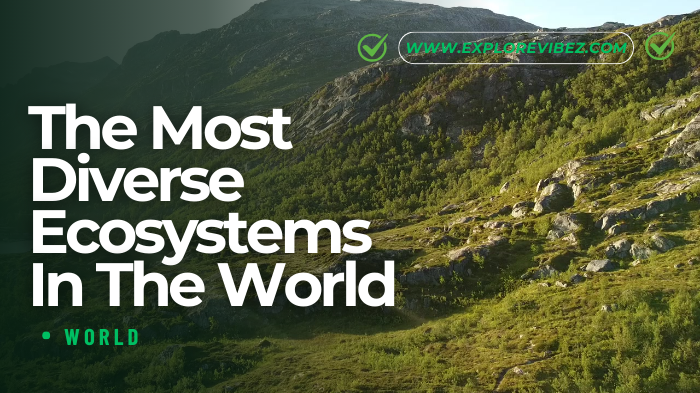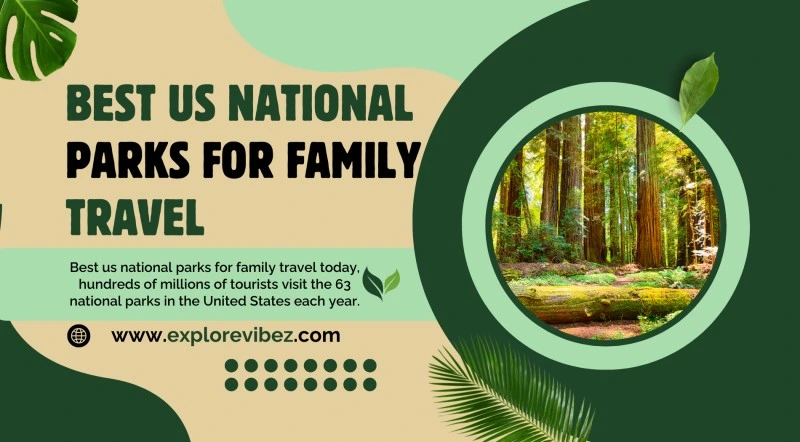For nature lovers, few things are more thrilling than traveling to one of the planet's most biodiverse locations. In 1998, British scientist Norman Myers first used the word biodiversity to describe regions with a high number of native species that require priority conservation status. Most diverse ecosystems in the world Stated differently, biodiverse hotspots are both endangered and wildlife-rich.
The initial list of 25 biodiverse locations has expanded to 36, or 2.5 percent of the planet's surface, since 2000. Particularly when traveling with children, some are more challenging to reach than others. Even yet, they continue to be the best places to see nature in its purest form and impart important environmental knowledge to kids. However, in order to have a positive influence on these areas, you must travel sensibly.
Top 10 Most Diverse Ecosystems In The World
1. The Amazon region of Brazil

The Amazon Rainforest is home to one-third of all species on Earth. It makes up 40% of South America, or an enormous 2.6 million square miles.
Brazil is the perfect destination for a biodiverse family holiday because it has more than half of the forest. What is the best approach to taking children to visit the Brazilian Amazon?
An Amazon River trip where your family may swim with river dolphins, fish for piranhas, see caimans at night, and visit primary forests, among other things.
Read also: Tripadvisor Top World Destinations
2. The Cloud Forests of Ecuador

Despite being marginally smaller than the U.S. state of Nevada, Ecuador is home to an astounding variety of habitats. The Amazon, the Sierra, and the Pacific Coast are among them.
Additionally, the country's cloud forests on both sides of the Andes are home to a diverse range of species, including birds, animals, butterflies, and orchids.
Enjoy chances for exhilarating outdoor activities like ziplining the canopy and tubing area streams in addition to discovering the varied flora and wildlife of Ecuador's cloud forests. This is all the information you want to organize the ideal family vacation to Ecuador.
3. The Monteverde Cloud Forest in Costa Rica

More than 425 bird species, 120 mammals species, 60 amphibian species, and 101 reptile species can all find sanctuary in Costa Rica's Monteverde Cloud Forest.
It has 3,200 plant species, including over 400 orchids and countless insects. The park is home to around half of Costa Rica's biodiversity overall.
That amounts to 2.5 percent of the total worldwide! Start by looking at our family-friendly schedule if you're searching for a kid-friendly method to see Costa Rica's most exciting locations.
4. The Backcountry of Alaska

When you think about biodiversity, you probably think of places like rainforests, but have you ever considered traveling to the wilderness of Alaska?
The world's greatest tracts of temperate rainforest are found there. One of our favorite features? Take your family to Chilkoot Inlet in Southeast Alaska, where they will be awed by the old-growth trees.
For further advice on planning the perfect vacation to America's final frontier, see our page on Alaska for families.
5. Chapada Diamantina in Brazil

One of the oldest and most varied tropical ecosystems on Earth is said to be found in Brazil's Cerrado. Visit Chapada Diamantina National Park to experience the Cerrado's ecosystems.
There, you'll fall in love with the park's remote waterfalls, rocky tabletop mountains, and vast valleys. Compared to other Brazilian biomes, such as the Amazon Rainforest, the Cerrado has not received the same level of environmental protection. However, well-spent tourism funds contribute to the preservation of this amazing place.
Find out more about the stunning waterfalls of Chapada Diamantina National Park and the ideal family-friendly travel schedule.
Read also: Exploring the World on a Budget: 10 Fantastic Travel Tips
6. The Sian Ka'an Biosphere Reserve in Mexico

The Sian Ka'an Biosphere Reserve in Mexico was appropriately named "Origin of the Sky" by the Maya, who previously called it home. The park, which is located on the east coast of the Yucatán Peninsula, is home to tropical forests, wetlands, and mangroves.
It also features a sizable expanse of ocean with a vibrant barrier reef. Along with a significant variety of mammals, reptiles, and amphibians, the region is home to over 300 different kinds of birds.
Of course, Sian Ka'an is only one of many locations to witness some of Mexico's most breathtaking ocean and landscape views. For further options, see our Mexico Family Vacation in Baja.
7. Manú National Park in Peru

You and your family will witness nature at its most pure when you visit Manú National Park, which is a must-see when exploring the Peruvian Amazon. There are hundreds of bird species, 221 animal species, and a variety of habitats in the park.
Manú is particularly well-known for its indigenous tribes, who live in isolation and still adhere to ancient ways of life. There are a ton of amazing ways to see this area, including taking a boat cruise to see caimans or watching a vibrant sunset.
With the Amazon extension included in our Peru family vacation package, your family may venture deep into this amazing nature.
8. The Floristic Province of California

The Golden State is renowned for its amazing experiences and views. Nonetheless, a trip to the California Floristic Province, which stretches from the Klamath River in Oregon into Northern California, is one of our top picks for exploring an old-growth forest.
Nearly 3,500 plant species may be found in this area, including some of the world's tallest trees and over 60% native plants. We're talking about heights of up to 300 feet!
In addition to amazing flora, the area serves as crucial nesting grounds for the critically endangered California condor. When you combine this with our California Road Trip Itinerary, your family trip will be one to remember.
9. The Coastal Forests of Tanzania

What comes to mind when you think about Africa? Maybe the Serengeti's boundless grasslands, where elephants, lions, hyenas, and wildebeests roam? If so, you are not by yourself.
After all, the fervent African safari business is driven by tourists' desire to see magnificent sights. However, East Africa's golden plains are not the only aspect of the continent.
Explore fragmented coastal forests with amazing biodiversity in Tanzania and Kenya. More than 4,000 plant species and endangered primates like the red colobus monkey can be found there.
Read also: A Guide to the World's Most Luxurious Spas and Wellness Retreats
10. The Caribbean Mangrove Forests of Colombia

Cispatá Bay is located on the Caribbean coast of Colombia and is home to 270,000 acres of mangrove forests. The trees that border the Sinú River give needle-nose crocodiles vital habitat.
Because mangrove forests may store up to 10 times as much carbon as other types of forests, their preservation is essential to the health of the world. Working with the proper travel experts is crucial since responsible, sustainable tourism contributes to mangrove protection.
conclusoin
As you can see, when it comes to organizing a family holiday in the planet's most biodiverse locations, there are countless fascinating options. Depending on the ages and interests of your family, we can assist you in creating the ideal itinerary, whether your interests are in the Amazon, the Alaskan Backcountry, or Ecuador's Cloud Forests. Have you considered learning how to visit Earth's most biodiverse places? We'll take care of you. We have the family travel know-how, local contacts, and travel experience to make your family vacation one to remember.
FAQ's: The Most Diverse Ecosystems In The World
Which is a more diverse ecosystem?
The tropics, a belt around the equator, have the maximum diversity, which begins to decline as one moves toward the polar regions.
What is the most diversified country in the world?
Liberia, Uganda, Togo, Nepal, South Africa, Chad, Kenya, Mali, Nigeria, and Guinea-Bissau are among the ten most varied nations. With a racial variety of 88.9%, Liberia is the most varied state on earth. With 88.3% racial variety, Uganda is not far behind.
Which place on Earth has the highest biodiversity?
Brazil is home to the Amazonian rainforest, a tropical environment. It is recognized as the planet with the most biodiversity. Over 40,000 plant species, 3,000 fish species, 1,300 bird species, 427 mammal species, 427 amphibian species, 378 reptile species, and over 1,25,000 invertebrate species may be found there.
What is the most diverse organism in the ecosystem?
The most diverse kind of beings are decomposers, which include bacteria, fungus, and other living things that convert the organic stuff that has collected in consumers' bodies into inorganic elements.
What are two diverse ecosystems?
The diversity of ecosystems, including wetlands, grasslands, forests, deserts, and seas, is an illustration of ecological diversity on a global scale. The greatest scale of biodiversity is ecological variety, and each ecosystem has a significant amount of genetic and biological diversity.











